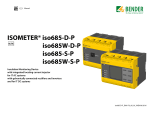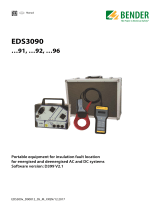Page is loading ...

Appendix to TGH 1266E - Page 1
EDS3065
in diode-decoupled systems
PSA3352
MESSZANGE / CLAMP ON PROBE
Datenblatt / Datasheet : TGH1320
Durchmesser / Diameter : 52 mm
Art.-Nr. / Art.-no. : B 980 695
max. 1 A
600 V CAT III
1000 mA / 0,1 mA ~
PSA3352
MESSZANGE / CLAMP ON PROBE
Datenblatt / Datasheet : TGH1320
Durchmesser / Diameter : 52 mm
Art.-Nr. / Art.-no. : B 980 695
max. 1 A
600 V CAT III
1000 mA / 0,1 mA ~
PSA3352
MESSZANGE / CLAMP ON PROBE
Datenblatt / Datasheet : TGH1320
Durchmesser / Diameter : 52 mm
Art.-Nr. / Art.-no. : B 980 695
max. 1 A
600 V CAT III
1000 mA / 0,1 mA ~
PGH183
100mA
1 mA
2,5mA
Imax
ON
ON
Us
L1(+)
L2(-)
L3
AC/DC
KE M+ M <LT> <PT> A
B
A-ISOMETER®
Serie 260
1 ALARM 2
A1(+) A2(-) AKL3L2L1
242221141211
(L/+) (L/-)
TEST
RESET
kΩ
MONITOR
L- L+
L+
L-
PGH185
S1 switchover
EDS/IMD
Insulation monitoring device,
e.g. IRDH265/365
DC - main distribution(DC 20-308 V)
Central connection of insulation monitoring
device (IMD) and test device PGH185
Us AC 230 V
clamp-on probe
clamp-on probe
EDS165-3
DC subdistribution
l max. = 10 m
l
m
a
x
.
=
1
0
m
L+
L-
consumer
insulation fault
consumer
EDS165
clamp-on probe
P1
P2
P1
P2
08.99

Appendix to TGH 1266E - Page 2
In some applications DC systems are diode decoupled. Between these
decoupled circuits compensating currents may occur. The quantity of the
currents and its direction depend on the system voltage, the characteristics of
the diodes and the kind of consumers installed in the system.
When the portable insulation fault location device EDS3065 is used in diode-
decoupled systems, the aforementioned compensating (or circulating)
currents will disturb the EDS3065 and will cause measuring faults. Therefore
BENDER recommends the use of the EDS3065 in diode-decoupled system
only according to the drawing on the previous page.
Additionally please consider the following:
• Always use two identical clamp-on probes. Caution: Do not forget
to set the correct clamp-on probe in the corresponding menu of
the EDS165.
• Use only 50Ω coaxial cable and a T-adaptor to connect both of the
clamp-on probes to the evaluating device EDS165.
• Do not exceed the max. length of the coaxial cable of 10 m per
clamp-on probe.
• Using two clamp-on probes according the BENDER drawing will
reduce the sensitivity of the EDS3065 by about 10 %.
• Always use the clamp-on probe in a way, that the energy flow direction
corresponds to the marking on the clamp-on probes (P1 => P2).
EDS3065
in diode-decoupled systems
Source IT-system
Consumer
PGH185
100mA
10mA
25mA
Imax
ON
ON
Us
L1(+)
L2(-)
L3
AC/DC
P1
P2
energy flow
direction

Appendix to TGH 1266E - Page 3
EDS3065
in diode-decoupled systems
How to find insulation faults:
• The central insulation monitoring device (IMD) has indicated an
insulation fault which is detectable by the EDS3065. Please refer to
chapter „Points to be considered before use“ in the EDS3065 manual
TGH1266E.
• Read the current insulation resistance from the insulation monitors
indication, e.g. the LC display when the IRDH265/365 is used.
If the indicated value of the insulation resistance is lower than the
max. detectable insulation fault of the EDS3065, then switch with S1
from the insulation monitor th the EDS 3065.
• Connect the test device PGH185 according to the drawing on page 1
to the electrical system. It is important to use the recommended
connecting points for the EDS185.
• Now prepare the evaluating device EDS165:
- connect the two identical clamp-on probes (PSA3054 or PSA3012)
with the coaxial cables and the T-adaptor.
- set the operating mode selector switch to position I∆n
- set following parameters:
menu 2: memory off
menu 3: buzzer on
menu 4: set sensor to the used clamp-on probe
menu 5: frequency 50 Hz
• Start of the EDS3065:
embrace the PE conductor of the PGH185 with one of the connected
clamp-on probes. If the test current I∆n indicated on the LC display
of the EDS165 is higher than 10 mA, a successful insulation fault
location is possible. Remove the clamp-on probe from the PE
conductor.
Now embrace the L+ and L- conductors with the clamp-on probe but
not the PE conductor.
• Fault location in the system:
Embrace the conductors (not the PE) of the redundant lines to the
consumers with a clamp-on probe each. Consider to embrace the
correct corresponding redundant lines. Consider the energy flow
direction (P1 => P2) of the clamp-on probes.
Embrace systematically and one after the other all parallel lines to the
consumers with the clamp-on probes. Insulation faults behind a
clamp-on probe will be indicated on the EDS165 display.
Caution: an alarm will be indicated about 30 seconds after embracing
the conductors with the clamp-on probe.
During insulation fault location please refer to the safety instructions
and operating instructions in the owners manual TGH1266E.

Appendix to TGH 1266E - Page 4
EDS3065
in diode-decoupled systems
Ordering details
Type Description Ref. No.
EDS3065 Case with PGH185, EDS165, PSA3012, PSA3054, 91 082 004
measuring accessories and battery charger
EDS3065-13 Case with PGH185, EDS165, PSA3012, PSA3054, 91 082 005
measuring accessories and battery charger
EDS165 EDS165 accessory for diode-decoupled DC systems. 91 082 007
accessory Contains 2 x 8 m BNC cable, 1 BNC T-adaptor and
2 BNC/BNC adaptors
PSA3012 clamp-on probe 980 748
PSA3054 clamp-on probe 980 698
/






